Brazil 2014 "Prehistoric Animals of Brazil"
| <prev | back to index | next> |
| Issue Date | 12.10.2014 |
| ID | Michel: 4178-4181, Scott: 3285a-ds, Stanley Gibbons: 3835-3838, Yvert et Tellier: 3361-3364, Category: pR |
| Designer | Paleoartist Rodolfo Nogueira consultant: paleontologist Prof. Dr. Luiz Eduardo Anelli Geosciences Institute of the University of Sao Paulo - USP/IGc |
| Stamps in set | 4 |
| Value | R$1,30 - Prionosuchus plummeri R$1,30 - Oxalaia quilomboensis R$1,30 - Pycnonemosaurus nevesi R$1,30 - Eremotherium lauriliardi |
| Emission/Type | commemorative |
| Places of issue | São Paulo / SP, São Luis / MA, Cuiabá / MT and São Raimundo Nonato / PI |
| Size (width x height) | 25mm x 35 mm ; 35mm x 25mm |
| Layout | Sheet of 24 stamps with 6 x blocks of 4 stamp |
| Products | FDC x1 with 4 different post marks |
| Paper | Gummed chalky paper |
| Perforation | 12 x 11,5 / 11,5 x 12 |
| Print Technique | Offset + UV varnish + coarse varnish |
| Printed by | Brazilian Mint |
| Quantity | stamps 900.000, post card 3.000 |
| Issuing Authority | Empresa Brasileira de Correios e Telegrafos |

On October 12th 2014, the Post Authority of Brazil issued the set of four stamps "Prehistoric Animals of Brazil".
All four stamps were printed together in sheets of 24 stamps - 6 blocks of 4.
These stamps depicted various prehistoric animals who roamed the territory of Brazil:
- Prionosuchus plummeri - Permian reptile
- Oxalaia quilomboensis - Cretaceous dinosaur with many other prehistoric animals on the background
- Pycnonemosaurus nevesi - Cretaceous dinosaur
- Eremotherium lauriliardi - Pleistocene mammal
 |
| The block with all four stamps of prehistoric animals of Brazil 2014. |
Rodolfo Nogueira explains:
I am Brazilian.
I reconstruct extinct animals, so I am a paleoartist.
I've been also working since 1998 with various illustration techniques as color pencil, graphite,
gouache, oil, watercolor, digital illustration, 3D modelling, animation and sculpture.
I was an undergraduate in Graphic Design at Universidade Estadual Paulista-UNESP.
With the soul of a biologist, I never left the infant stage of liking dinosaurs.
As an undergraduate I have developed a methodology to illustrate prehistoric animals with the detailed study of
functional morphology, ecology and environment.
In order to create scientific correct images for the stamps set, paleontologist Prof. Dr. Luiz Eduardo Anelli from Geosciences Institute of the University of Sao Paulo, supervised the work of Rodolfo.
Rodolfo Nogueira and Dr. Luiz Eduardo Anelli have a long history of cooperation, which continued after the stamps were issued.
In 2017, for example, Nogueira was responsible for the illustrations of the book "O Brasil dos Dinossauros", by paleontologist Luiz Eduardo Anelli, published by Marte Cultura e Educação.
The work, of 132 pages and large size (51 cm x 24.5 cm), presents detailed research on the daily lives of dinosaurs that lived in Brazil during ancient times. The focus of the illustrations, which occupy most of the book, is to portray not only the dinosaurs but also their environment.
First Day Ceremonies for these stamps were held at four Brazilian cities: Sao Paulo, Sao Luis, Sao Raimundo and Cuiba. First-Day-of-Issue Postmarks were issued for each of the cities.
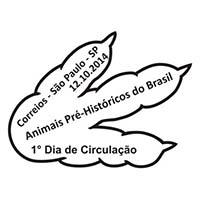 |
 |
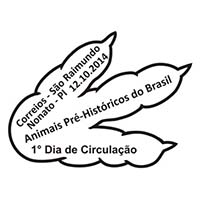 |
 |
Rodolfo and Luiz toured Brazil to present these postage stamps. The images below, shows both men at one of such presentations. After the presentation Mr. Nogueira and Anelli kindly signed some covers and mini-sheets for some philatelists.
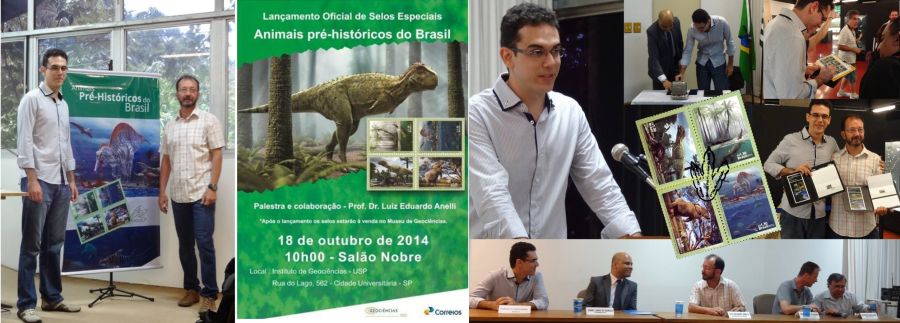
The artist Rodolfo Nogueira (young man in blue shirt) and scientific consultant, paleontologist Prof. Dr. Luiz Eduardo Anelli (on the right side on the left image) on the tour. Images credit: facebook page of Rodolfo Nogueira
The following text is based on text written by Prof. Dr. Luiz Eduardo Anelli of the Geosciences Institute of the University of Sao Paulo, for the information flyer for these stamps.
 |
As ancient inhabitants of this land, they survived or disappeared in large extinctions, saw the birth of South America, felt the scent of the first flowers, made Brazilian pre-history happen. Know and admire it is a duty of all Brazilians, not only as part of the history of the country, its geography and landscapes, fauna and flora, but as Brazilian own history.
For hundreds of millions of years, huge depressions of the crust on which we live accumulated sediments and debris coming from the mountains time wore off. They were brought immersed in glaciers that remained in these lands for millions of years, in marine currents of ancient continental seas established here, by the winds of a hellish desert, or then in the fluidity of countless rivers and lakes that are long gone.
Hardened by the heat from the inner Earth, by the immense weight of the column of sediment, and the chemistry of the waters that penetrated them; these sediments were transformed into rocks. Out of those we took good part of the riches which enable us to live, including plenty of water, limestone and oil. But they keep other valuable treasures, signs and traces of the rich and vigorous life that uninterruptedly dwelt these lands in a deep and remote past.
In these huge packages of rock stacked by time are packaged skeletons and trunks, footprints and traces of life that existed here in the last three major geological eras, eye witnesses of Brazilian pre-history. In recognition of this, and the work of countless generations of Brazilian geologists and paleontologists, the Brazilian Post depicts in special stamps four magnificent pre-historic creatures that once inhabited these lands.
The first stamp depicts the Permian period, from 270 million years ago.
In a lake that is located today in Parnaíba in Piauí, Prionosuchus plummeri one captures a Ceratodus fish while another individual rests in the shade of ferns Psaronius of 15 meters high.
 |
 |
| Prionosuchus plummeri and Psaronius on stamp of Brazil 2014 (MiNr.: 4178, Scott: 3285a) and digital design | |
- Name: Prionosuchus plummeriv
- Meaning of the Name: Although it may be an amphibian, his name means "sierra crocodile"
- Where it was found: state of Maranhao
- When it lived: Permian Period, 270 million years ago
- Dimensions: Length: 9m, Weight: 1-2t
Prionosuchus is the largest known amphibian, because it reached to nine meters in length. It had a long nozzle filled with sharp teeth, and an elongated body with too short members. Its role was the same as the current crocodiles: devouring fish and any other aquatic creatures.
The second stamp portrays the extremely rich fauna that lived during the Cretaceous period at the Lage do Coringa, 95 million years ago, which today is located at Cajual Island, in Maranhao State.
The stamp shows a scene at a river bank - with reconstructions of both the terrestrial animals on land and the underwater animals living in the river.
The animal taking center place on this stamp is Oxalaia quilomboensis. This dinosaur is shown feeding on the remains of the shark, Atlanticopristis. Flying above Oxalia, is the large Pterosaur, Anhanguera. To the left of Oxalia is a family of herbivorous Titanosaurid sauropods. On the right of Oxalia, are a pair of long-necked dinosaurs of the genus Andesaurus and a carnivore, Masiakasaurus.
The lower half of the stamp shows an underwater scene with a variety of fish. In the upper left foreground is the large coelacanth, Mawsonia. In the lower right foreground is the shark, Tribodus. In the upper right foreground is the ray-finned fish, Lepidotes. In the lower left foreground, is a pair of fish including a bony fish in the order Pycnodonti formes and a Myliobatid ray. In the foreground between Tribodus and Lepidotes, is a Ceratodontid lungfish. In the center background, is a second shark Atlanticopristis. In the upper left background are second individuals of Tribodus and Lepidotes.
 |
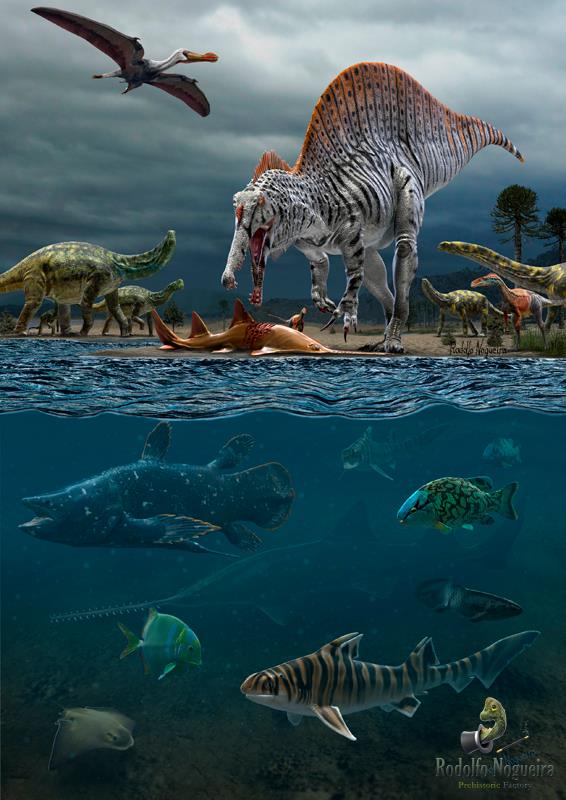 |
| Oxalaia quilomboensi on stamps of Brazil 2014 (MiNr.: 4179, Scott: 3285b) and digital design | |
- Name: Oxalaia quilomboensis
- Meaning of the Name: In tribute to Oxalá, a god of African legends
- Where it was found: Cajual Island, state of Maranhao
- When it lived: Cretaceous Period, 98 million years ago
- Dimensions: Length: 14m, High: 3m, Weight: 7t
In 2010 a group of paleontologists announced the discovery in rocks of Maranhao state coast of fossilized remnants that belonged to the largest predator dinosaur known to Brazilian lands: Oxalaia quilomboensis, which reached up to 13 meters in length.
Different from what is commonly expected of a carnivore dinosaur, Oxalaia did not run behind its prey, it was apatient and experienced fisher. With its long beak and slightly bent teeth, it would quickly pounce on fish from shore.
The third stamp illustrates the Cretaceous period 65 million years ago, in the region of Uberaba, Minas Gerais. A Pycnonemosaurus carnivorous dinosaur feeds on the carcass of a herbivorous dinosaur Uberabatitan ribeiroi herbivorous dinosaur. In the background of the image, we see two dinosaurs of the same species eating on conifers and, on the lake shore, rests a Uberabasuchus terrificus crocodilian.
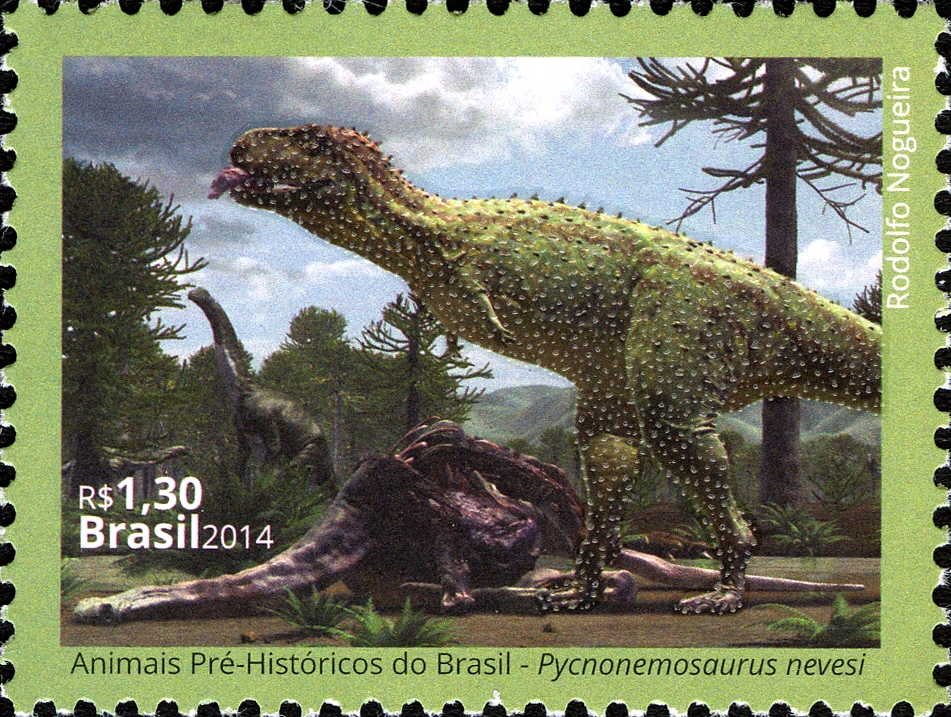 |
 |
| Pycnonemosaurus nevesi on stamps of Brazil 2014 (MiNr.: 4180, Scott: 3285c) and digital design | |
- Name: Pycnonemosaurus nevesi
- Meaning of the Name: Dense forest lizard
- Where it was found: state of Mato Grosso
- When it lived: Cretaceous Period, 70 million years ago
- Dimensions: Length: 8m, High: 3m, Weight: 4t
During the Cretaceous Period, these abelisaurid dinosaurs lived exclusively in continents south of the Equator.
They were robust animal, short-skulled, very with powerful rear legs, and arms exaggeratedly shriveled. Its fossilized remnants are found all over Brazil. At that time, huge herbivore dinosaurs from the titanosaurs family grazed in these lands and were among its favorite prey.
During this part of the Cretaceous, Brazil was arid. During this time, Pycnonemosaurus would have had difficulty feeding not only its young but also itself due to its large size (8 meters!).
Titanosaurs were difficult prey because they had their own defensive strategies including hard bony plates on their backs and enormous tails that would knock down any large predator.
The fourth stamp shows two Eremotherium laurillardi, that lived during the Pleistocene epoch, the epoch preceding the Holocene epoch that we are living in.
In the foreground, an individual Eremotheirum is shown in an erect, bipedal position reaching for leaves at the top of a tree. In the background, a second individual is shown walking on all four legs. On the foreground, a specimen erects in biped position to reach leaves on top of a tree. On the background, another specimen moves searching for a tree.
 |
 |
| Eremotherium laurillardi on stamps of Brazil 2014 (MiNr.: 4181, Scott: 3285d) and digital design | |
- Name: Eremotherium laurillardi
- Meaning of the Name: Solitary creature
- Where it was found: All over Brazil
- When it lived: Pliocene and Pleistocene Epochs, between 5 million and 10 thousand years ago
- Dimensions: Length: 6m, Weight: 3t
One group of mammals that diversified in South America were the Xenarthra. While the name is not likely familiar to most people, some Xenarthrans are familiar like the armadillos, sloths, and anteaters. Today, their descendants are small - but in the past, they were much larger! Some armadillos were the size of a Volkswagen Beatle, while Sloths could reach the height of a bus.
Eremotherium was a giant sloth who dwelt in Brazil five million to ten thousand years ago, during the Pliocene and Pleistocene epochs. At the end of the last ice age, the drastic changes to climate and vegetation occurred leading to the eventual extinction of the gigantic Xenarthrans. Humans that moved into South America likely also helped cause their extinction by hunting them. "
Products and associated philatelic items
| FDC | First-Day-of-Issue Postmark | |
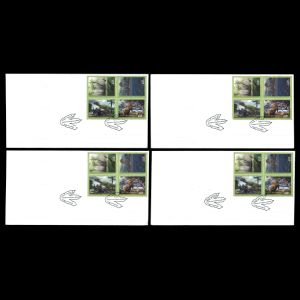 |
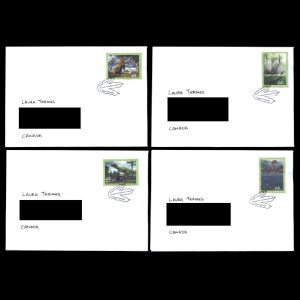 |
 |
| The official FDC produced by Brazilian Post was on a white cover without cachet. The cover is engraved with the name of the Post: Correios. | ||
| Signed FDC | Post Card | Sheet of Stamps |
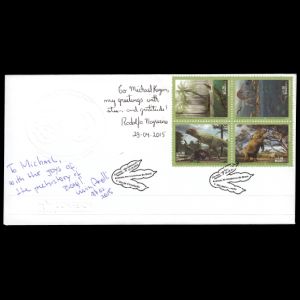 |
 |
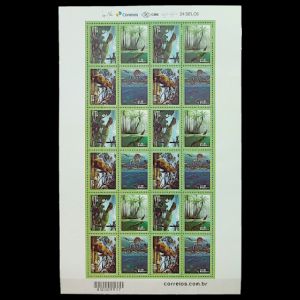 |
| Example of circulated covers | ||
 |
 |
 |

|
References
- Technical details and description of the stamps: Official booklet (PDF file), Selose Filatelia, Philatelic and Numismatic Association of Brasilia, Tyrannus Melancholicus.
- Rodolfo Nogueira: Wikipedia, folha.uol.com.br.
- Luiz Eduardo Anelli: Wikipedia
Acknowledgements
Many thanks to Dr. Peter Voice from Department of Geological and Environmental Sciences, Western Michigan University, for his help to find an information for this article, the draft page review and his very valuable comments.| <prev | back to index | next> |